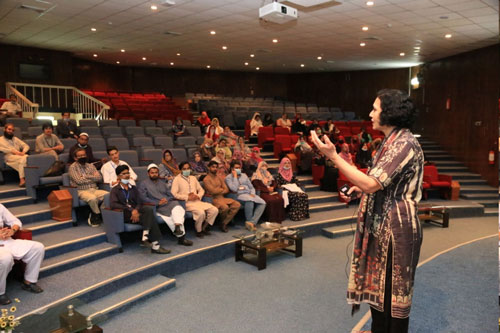Staff Reporter
“Dengue Fever is still a challenge for as many as 129 countries in the world, including Pakistan.
Following the ongoing Covid-19 pandemic, diagnostic work-up for dengue is absolutely essential, while the missing diagnosis has its consequences as there is a rapid increase in infections and deaths since 2000.
Citizens must follow precautionary measures against the fatal disease as dengue virus causing dengue fever is transmitted by female mosquitoes mainly of the species Aedes.
Rural to urban migration is one of the major factors supporting the viral transmission in the developing countries.”
Dr. Bushra Jamil Ali, Professor at the Department of Medicine, Aga Khan University, Karachi, expressed these views while speaking at the public awareness seminar on “Prevention of Dengue” held in the Prof.
Salimuzzaman Siddiqui Auditorium of the ICCBS, organized by Dr. Panjwani Center for Molecular Medicine and Drug Research (PCMD), University of Karachi.
She said that there were 390 million infections are reported per year worldwide, while 70 percent of the disease burden was in Asia. Around 25 percent of the dengue cases are symptomatic while others are asymptomatic, she said.
She said, “Dengue virus is transmitted by female mosquitoes mainly of the species Aedes, while Aedes albopictus is found predominantly in District Mirpur, Azad Jammu, and Kashmir, Pakistan.”
She said that there were several factors, including rapid population growth, rural to urban migration, inadequate basic urban structure, and increase in the volume of solid, which provides larval habitats in urban areas, which are supporting the viral transmission in the developing countries.
The most common symptom of dengue is fever with some other issues like nausea, vomiting, rash, aches, and pains (eye pain, typically behind the eyes, muscle, joint, or bone pain), the lady professor said.
She pointed out that management and therefore outcomes could be substantially improved if an early, correct diagnosis was made.
Appropriate management consists of hydration and follow-up; prevent progression into a severe stage, she added.
A very few patients develop severe dengue, which is characterized by complications including severe bleeding, organ impairment, and plasma leakage, she said.
Severe dengue has a higher risk of death when not managed appropriately, while mortality is less than one percent if managed appropriately, she mentioned.
The mainstay of prevention currently is the elimination of mosquito breeding within households and the use of mosquito repellants, she said, adding that vaccine dengue is available but has limitations.










